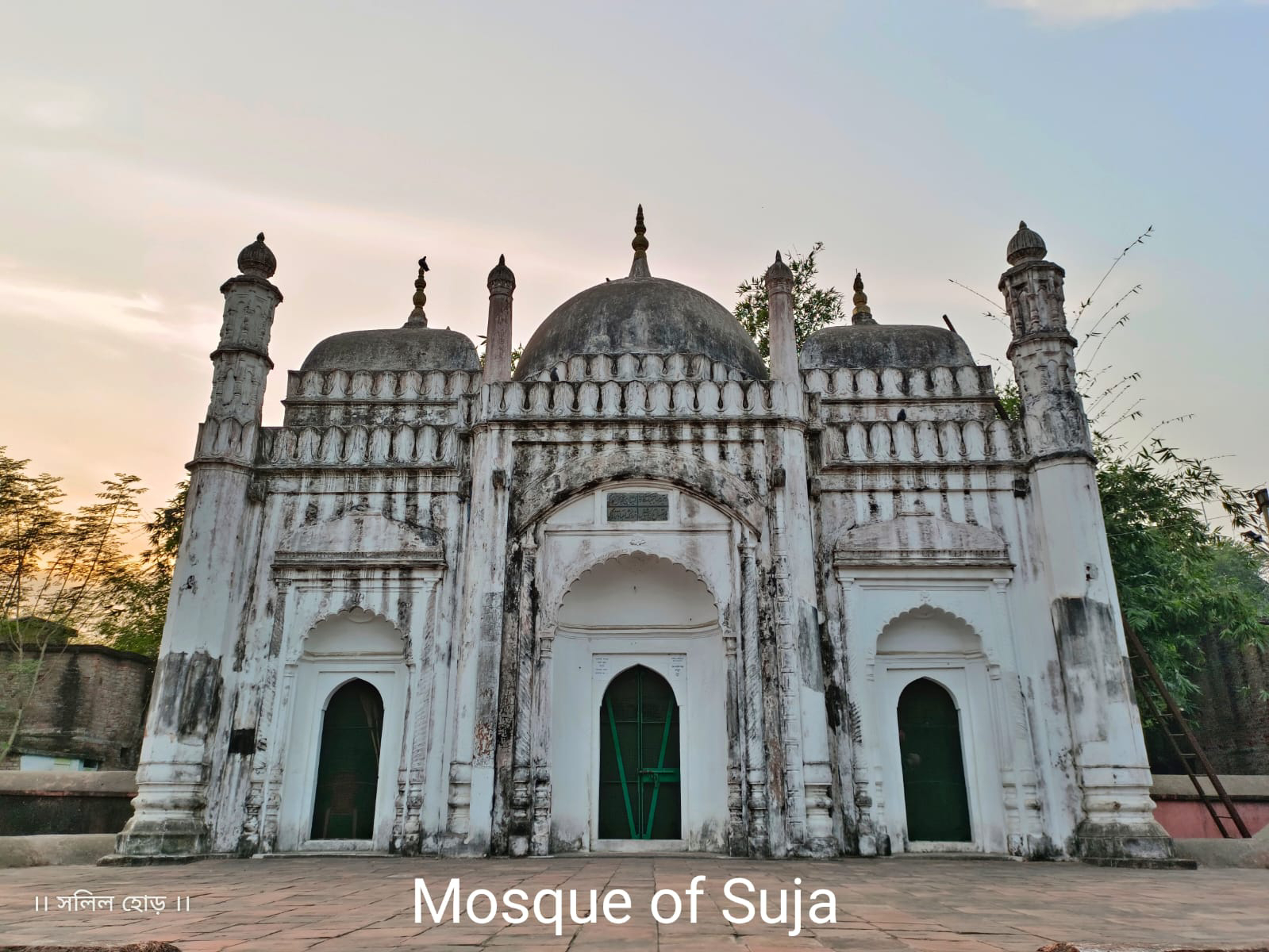সুজাউদ্দিন খানের মসজিদ ও সমাধি, রোশনিবাগ (Tumb and Mosque of Shuja Uddin Khan, Roshnibagh)
সুজাউদ্দিন খানের পুরো নাম মুতামুল মুলক মির্জা সুজাউদ্দিন মহম্মদ খাঁ আসাদ জং। ১৬৭০ খ্রিস্টাব্দ নাগাদ বুরহানপুরে তার জন্ম হয়। নবাব মুর্শিদকুলি খানের অধীনে তিনি চাকরি করার সময়, নবাবের স্নেহভাজন হন, এবং ১৭১৯ খ্রিস্টাব্দে তিনি উড়িষ্যার সুবেদারের পদে উন্নীত হন। নবাবকন্যা আজিমুন্নিসা বেগমের সাথে সুজাউদ্দিন বিবাহসূত্রে আবদ্ধ হন। মুর্শিদকুলি খানের মৃত্যুর পর তিনি সুবে বাংলার দ্বিতীয় নবাব হিসেবে মুর্শিদাবাদের সিংহাসনে বসেন।
ভোগবিলাসী জীবনযাপনের জন্য স্ত্রীয়ের সাথে তার সম্পর্ক ভালো ছিল না। কিন্তু রাজত্ব শাসনের বিষয়ে ছিলেন অনেকটাই দক্ষ, এবং নিয়মিত মুঘল দরবারে রাজস্ব পাঠাতেন (বছরে প্রায় ১ কোটি ২৫ লক্ষ টাকা)। তাই তৎকালীন দিল্লির বাদশাহের সাথে, সুজাউদ্দিনের সম্পর্ক ছিল খুবই ভালো। বিরাট একটি সেনাবাহিনী তিনি রেখেছিলেন, যার মধ্যে ছিল বাঙালি, আফগানি, তুর্কি ও তেলেঙ্গানার সৈন্যরা এবং একটি নৌসেনা বাহিনী। সুবে বাংলাকে তিনি শাসনের সুবিধার্থে চার ভাগে ভাগ করে দেন -
১. পশ্চিমবঙ্গ, মধ্যবঙ্গ ও উত্তরবঙ্গের কিছু অংশ নিয়ে কেন্দ্রীয় বিভাগ।
২. পূর্ববঙ্গ, দক্ষিণবঙ্গ, শ্রীহট্ট ও চট্টগ্রাম নিয়ে ঢাকা বিভাগ।
৩. বিহার বিভাগ।
৪. উড়িষ্যা বিভাগ।
নবাব সুজাউদ্দিন ছিলেন খুব উদার এবং অতিথিপরায়ণ। কিন্তু তার সাথে তিনি ছিলেন খামখেয়ালী এবং বিলাসপ্রিয়। সুসজ্জিত জৌলুস সমারোহে তিনি সোনা রূপার মুদ্রা ছড়াতে ছড়াতে নমাজ পড়তে যেতেন। তিনি মুর্শিদাবাদে তৎকালীন দিল্লিতে অবস্থিত শাহীমহলের অনুকরণে অনেক বাড়ি তৈরী করেন। মুর্শিদাবাদে শাহীমঞ্জিল (রাজভবন), শাহী দরওয়াজা (প্রবেশতোরণ), দরবার - ই - আম (জনগণের দরবার), খিলাওয়াত খানা (খোসকাচারী), দহপাড়া মসজিদ, ফারহাবাগ (আনন্দকানন) এবং রোশনিবাগ নির্মাণ করেন। এই রোশনিবাগ বর্তমানে ভাগীরথী নদীর পশ্চিম পাড়ে অবস্থিত, যেখানে সুজাউদ্দিন একটি ছোট মসজিদ নির্মাণ করিয়েছিলেন। এটিই সুজাউদ্দিন মসজিদ হিসেবে পরিচিত।
নবাবের ছিল বিরাট হারেম, যেখানে সম্রাট সূরা এবং নৃত্যগীতে মেতে থাকতেন। এর ফলে রাজকার্যে ঢিলেমি দেখা দিয়েছিল। সেই অবস্থায় খামখেয়ালী নবাব সমস্ত রাজ্যভার তুলে দিলেন তার মন্ত্রীদের হাতে, এবং জীবনের শেষ দিন পর্যন্ত ভোগবিলাসী জীবন যাপন করেন। ১৭৩৯ খ্রিস্টাব্দের ২৬শে আগস্ট সুজাউদ্দিনের মৃত্যু হলে, তাকে রোশনিবাগেই মসজিদের পাশে সমাধিস্থ করা হয়। সমাধিটি আয়তকার একটি ভবনের মাঝে রয়েছে। ভবনটির দুই পাশে আছে দরজা, আর বাকি দুই পাশে আছে জাল লাগানো জানালা।
রোশনিবাগে সুজাউদ্দিনের সমাধি ছাড়াও আরো চারটি সমাধি আছে। তার দুইটির একটি হচ্ছে বাগদাদ থেকে আগত দরবেশ সফি রহমতুল্লাহ এবং অপরটি হচ্ছে দাতাসাহেব নামে অপর একজন ফকিরের। এই দুই দরবেশের স্মৃতির উদ্দেশ্যে এখানে প্রতি বছর চৈত্র মাসের ৩ থেকে ৭ তারিখ জাকজমকপূর্ণ আনন্দ-উৎসবের আয়োজন করা হয়।
(English Version)
Tomb and Mosque of Shuja-ud-Din Khan, Roshnibagh
Shuja-ud-Din Khan, whose full name was Mutamul Mulk Mirza Shuja-ud-Din Muhammad Khan Asad Jang, was born around 1670 CE in Burhanpur. While serving under Nawab Murshid Quli Khan, he earned the Nawab's favor and was promoted to the position of Subedar of Odisha in 1719 CE. Shuja-ud-Din married Azimunnisa Begum, the Nawab's daughter. After Murshid Quli Khan's death, he ascended the throne of Murshidabad as the second Nawab of Bengal Subah.
His extravagant lifestyle strained his relationship with his wife, yet he proved to be a highly capable ruler. He regularly remitted revenue to the Mughal court, sending approximately 1.25 crore rupees annually. Consequently, Shuja-ud-Din maintained excellent relations with the then-Emperor of Delhi. He commanded a vast army comprising Bengali, Afghani, Turkish, and Telanganese soldiers, along with a naval force. For administrative convenience, he divided the Bengal Subah into four divisions:
1. Central Division: Encompassing West Bengal, Central Bengal, and parts of North Bengal.
2. Dhaka Division: Including East Bengal, South Bengal, Sylhet, and Chittagong.
3. Bihar Division.
4. Odisha Division.
Nawab Shuja-ud-Din was known for his generosity and hospitality, though he was also whimsical and pleasure-loving. He would scatter gold and silver coins in lavish splendor on his way to offer prayers. In Murshidabad, he constructed numerous buildings, imitating the royal palaces of contemporary Delhi. Among his creations in Murshidabad were Shahi Manzil (the royal palace), Shahi Darwaza (the royal gateway), Durbar-i-Am (the public court), Khilawat Khana (a private chamber), Dahpara Mosque, Farhabagh (a pleasure garden), and Roshnibagh. This Roshnibagh is currently situated on the west bank of the Bhagirathi River, where Shuja-ud-Din had a small mosque built, which is now known as Shuja-ud-Din Mosque.
The Nawab maintained a large harem, where he indulged in wine, song, and dance, leading to negligence in state affairs. In this state, the whimsical Nawab handed over all administrative responsibilities to his ministers and continued his life of indulgence until his last day. Shuja-ud-Din passed away on August 26, 1739 CE, and was interred next to the mosque in Roshnibagh. His tomb is located in the center of a rectangular building, which features doorways on two sides and latticed windows on the other two.
Besides Shuja-ud-Din's tomb, Roshnibagh houses four other tombs. Two of these belong to Sufi saints: Safi Rahmatullah, who came from Baghdad, and another faqir known as Data Saheb. In memory of these two dervishes, grand festivities and celebrations are held here annually from the 3rd to the 7th of the Bengali month of Chaitra.






Comments
Post a Comment